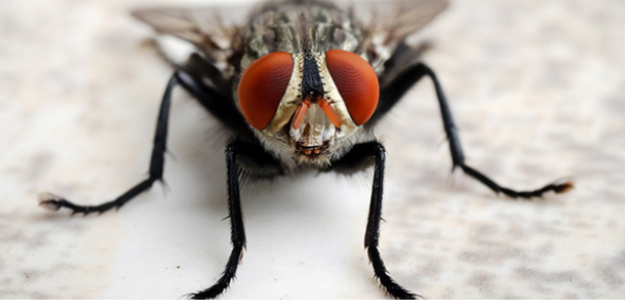Fly Control:

INTRODUCTION
House flies can be a big nuisance to anyone and their constant buzzing around can really get on your nerves. For businesses, particularly those in the food and pharmaceutical industries, they can be a huge concern due to the impact they can have on consumer health.
They can survive in all habitats where people can survive, because they are accustomed to the life near humans. Human flies are pests because they easily reproduce and transmit numerous diseases. People apply various insecticides to eradicate them, but they are still very numerous and even resistant to some of those chemicals. On the other hand, house flies are beneficial because they accelerate recycling process by decomposing organic waste.
FACTS ABOUT HOUSE FLIES
- House fly is small insect that can reach ¼ of inch in length.
- House fly is grey in color. It has four dark stripes on the back side of the body.
- Unlike other insects, house fly has only one pair of membranous wings. Second pair of wings is reduced and looks like a pair of miniature drumsticks. This pair of wings (known as "halters") is used for balancing during the flight.
- House flies are able to move their wings 200 times per second.
- House fly can fly at the speed of 5 miles per hour.
- House fly produces sticky substance which keeps the fly firmly attached to the ground (it acts like glue after landing).
- House fly has red compound eyes. Each eye contains 4000 lenses that enable visualization of different pictures at the same time. Despite huge number of lenses, house fly has poor eyesight.
- House fly relies mostly on the sense of smell when it searches for food. Sense of smell is located in the antennas.
- House fly eats sugary liquids and different kinds of organic waste. All food needs to be turned into liquid before ingestion because fly does not have teeth and ability to chew food. House fly spits digestive juices on the food to decompose it before swallowing.
- House flies are carriers of numerous pathogenic bacteria. Gangrene, tuberculosis, dysentery, anthrax, plague and different types of poisoning are just some of diseases transmitted by flies.
- House flies defecate every couple of minutes. This is one of the factors that facilitate transmission of diseases.
- House flies are active during the day. They rest during the night.
- Females can lay up to 2500 eggs usually on the food they eat. House flies undergo complete metamorphosis: egg will transform into larvae, larvae will transform into pupa and pupa will give rise to adult insect. Complete development lasts 10 days.
- House flies have incredible high reproductive capacity. Without natural predators, one couple of flies and their offspring would be able to cover all continents on Earth to the height of 18 feet after couple of months of reproduction.
- House fly can survive from 30 to 60 days.
LIFE CYCLE

CONTROL MEASURES
The First step in House fly control is exclusion and sanitation. After these measures, you can use insecticides that come in residual forms, aerosols, fogging materials, and baiting forms. Fly traps have long been a favorite. There are many forms of fly traps, from disposable fly traps to electronic fly light traps with replaceable light bulbs and glue boards.
EXCLUSION AND SANITATION
- Sanitation is the first measure of defense, even though there are various traps and sprays that are used to kill flies, it is necessary to eliminate the source in order to eliminate them.
- Whenever possible, food and materials on which the flies can lay their eggs must be removed or destroyed, which will isolate the egg-laying adult. Killing adult flies will reduce infestation, but elimination of breeding areas is necessary for good House Fly control management.
- Garbage cans and dumpsters should have tight-fitting lids and be cleaned regularly.
- Drainage will often aid control, getting rid of extra moisture.
- Openings of buildings should be tightly screened with screen.
- Strip curtains or Air showers can be installed on the main entrance.